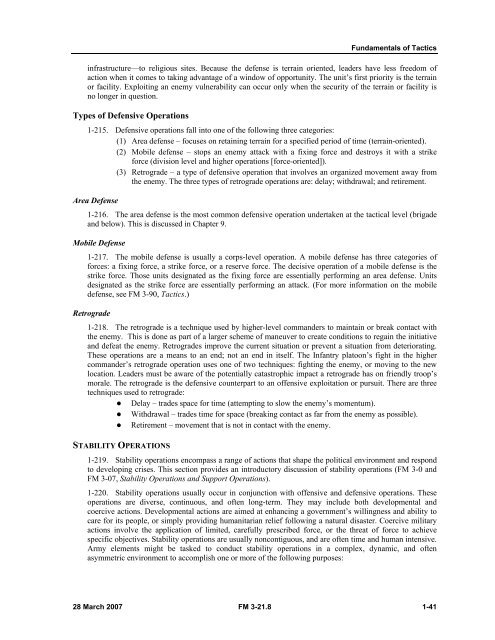Infantry Rifle Platoon and Squad - Sakai
Infantry Rifle Platoon and Squad - Sakai
Infantry Rifle Platoon and Squad - Sakai
Create successful ePaper yourself
Turn your PDF publications into a flip-book with our unique Google optimized e-Paper software.
Fundamentals of Tactics<br />
infrastructure—to religious sites. Because the defense is terrain oriented, leaders have less freedom of<br />
action when it comes to taking advantage of a window of opportunity. The unit’s first priority is the terrain<br />
or facility. Exploiting an enemy vulnerability can occur only when the security of the terrain or facility is<br />
no longer in question.<br />
Types of Defensive Operations<br />
1-215. Defensive operations fall into one of the following three categories:<br />
(1) Area defense – focuses on retaining terrain for a specified period of time (terrain-oriented).<br />
(2) Mobile defense – stops an enemy attack with a fixing force <strong>and</strong> destroys it with a strike<br />
force (division level <strong>and</strong> higher operations [force-oriented]).<br />
(3) Retrograde – a type of defensive operation that involves an organized movement away from<br />
the enemy. The three types of retrograde operations are: delay; withdrawal; <strong>and</strong> retirement.<br />
Area Defense<br />
1-216. The area defense is the most common defensive operation undertaken at the tactical level (brigade<br />
<strong>and</strong> below). This is discussed in Chapter 9.<br />
Mobile Defense<br />
1-217. The mobile defense is usually a corps-level operation. A mobile defense has three categories of<br />
forces: a fixing force, a strike force, or a reserve force. The decisive operation of a mobile defense is the<br />
strike force. Those units designated as the fixing force are essentially performing an area defense. Units<br />
designated as the strike force are essentially performing an attack. (For more information on the mobile<br />
defense, see FM 3-90, Tactics.)<br />
Retrograde<br />
1-218. The retrograde is a technique used by higher-level comm<strong>and</strong>ers to maintain or break contact with<br />
the enemy. This is done as part of a larger scheme of maneuver to create conditions to regain the initiative<br />
<strong>and</strong> defeat the enemy. Retrogrades improve the current situation or prevent a situation from deteriorating.<br />
These operations are a means to an end; not an end in itself. The <strong>Infantry</strong> platoon’s fight in the higher<br />
comm<strong>and</strong>er’s retrograde operation uses one of two techniques: fighting the enemy, or moving to the new<br />
location. Leaders must be aware of the potentially catastrophic impact a retrograde has on friendly troop’s<br />
morale. The retrograde is the defensive counterpart to an offensive exploitation or pursuit. There are three<br />
techniques used to retrograde:<br />
• Delay – trades space for time (attempting to slow the enemy’s momentum).<br />
• Withdrawal – trades time for space (breaking contact as far from the enemy as possible).<br />
• Retirement – movement that is not in contact with the enemy.<br />
STABILITY OPERATIONS<br />
1-219. Stability operations encompass a range of actions that shape the political environment <strong>and</strong> respond<br />
to developing crises. This section provides an introductory discussion of stability operations (FM 3-0 <strong>and</strong><br />
FM 3-07, Stability Operations <strong>and</strong> Support Operations).<br />
1-220. Stability operations usually occur in conjunction with offensive <strong>and</strong> defensive operations. These<br />
operations are diverse, continuous, <strong>and</strong> often long-term. They may include both developmental <strong>and</strong><br />
coercive actions. Developmental actions are aimed at enhancing a government’s willingness <strong>and</strong> ability to<br />
care for its people, or simply providing humanitarian relief following a natural disaster. Coercive military<br />
actions involve the application of limited, carefully prescribed force, or the threat of force to achieve<br />
specific objectives. Stability operations are usually noncontiguous, <strong>and</strong> are often time <strong>and</strong> human intensive.<br />
Army elements might be tasked to conduct stability operations in a complex, dynamic, <strong>and</strong> often<br />
asymmetric environment to accomplish one or more of the following purposes:<br />
28 March 2007 FM 3-21.8 1-41

















